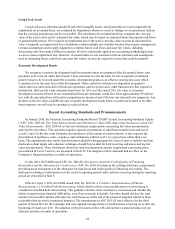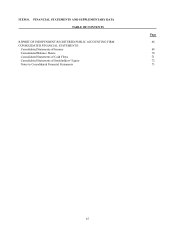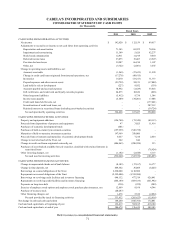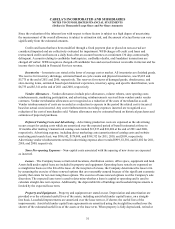Cabela's 2011 Annual Report Download - page 75
Download and view the complete annual report
Please find page 75 of the 2011 Cabela's annual report below. You can navigate through the pages in the report by either clicking on the pages listed below, or by using the keyword search tool below to find specific information within the annual report.
65
Effective June 16, 2011, the FASB issued ASU No. 2011-05, Comprehensive Income, requiring entities to
report components of other comprehensive income in either a single continuous statement or in two separate but
consecutive statements of net income and other comprehensive income. This ASU does not change the items that
must be reported in comprehensive income, how these items are measured, or when these items must be classified
to net income. ASU 2011-05 is effective for financial statements issued by the Company after January 1, 2012.
Effective December 23, 2011, the FASB issued ASU 2011-12, which indefinitely deferred, pending further
deliberation by the FASB at a future date, the effective date of certain provisions of ASU 2011-05 relating to the
reclassification of items out of accumulated other comprehensive income. We will provide the required financial
reporting presentation in the Company’s first fiscal quarter of 2012.
Effective September 15, 2011, the FASB issued ASU No. 2011-08, Testing Goodwill for Impairment, which
gives companies testing goodwill for impairment the option of performing a qualitative assessment before
calculating the fair value of a reporting unit in step one of the goodwill impairment test. If companies determine,
based on qualitative factors, that the fair value of a reporting unit is more likely than not less than the carrying
amount, the two-step impairment test would be required. Otherwise, further testing would not be needed. ASU
2011-08 is effective for annual and interim goodwill impairment tests performed for fiscal years beginning after
December 15, 2011, or effective for the first quarter of 2012 for the Company, with early adoption permitted. The
value of our goodwill will not be affected by the adoption of the provisions of this ASU.
ITEM 7A. QUANTITATIVE AND QUALITATIVE DISCLOSURES ABOUT MARKET RISK
We are exposed to interest rate risk through WFB’s operations and, to a lesser extent, through our
merchandising operations. We also are exposed to foreign currency risk through our merchandising operations.
Financial Services Interest Rate Risk
Interest rate risk refers to changes in earnings due to interest rate changes. To the extent that interest income
collected on credit card loans and interest expense on certificates of deposit and secured borrowings do not respond
equally to changes in interest rates, or that rates do not change uniformly, earnings could be affected. The variable
rate credit card loans are indexed to the one month London Interbank Offered Rate (“LIBOR”) and the credit card
portfolio is segmented into risk-based pricing tiers each with a different interest margin. Variable rate secured
borrowings are indexed to LIBOR-based rates of interest and are periodically repriced. Certificates of deposit and
fixed rate secured borrowings are priced at the current prevailing market rate at the time of issuance. We manage
and mitigate our interest rate sensitivity through several techniques, but primarily by indexing the customer rates
to the same index as our cost of funds. Additional techniques we use include managing the maturity, repricing, and
mix of fixed and variable assets and liabilities by issuing fixed rate secured borrowings or certificates of deposit
and entering into interest rate swaps.
The table below shows the mix of our credit card account balances as a percentage of total balances
outstanding at the years ended:
2011 2010 2009
Balances carrying an interest rate based upon various
interest rate indices 61.7% 61.9% 65.2%
Balances carrying an interest rate of 9.99% 4.1 3.9 2.5
Balances carrying a promotional interest rate of 0.00% 0.2 0.2 0.6
Balances not carrying interest because the previous
month balance was paid in full 34.0 34.0 31.7
100.0% 100.0% 100.0%
Charges on the credit cards issued by our Financial Services segment were priced at a margin over various
defined lending rates. No interest is charged if the account is paid in full within 25 days of the billing cycle, which
represented 34.0% of total balances outstanding at December 31, 2011. Some of the zero percentage promotion
expenses are passed through to the merchandise vendors for each specific promotion offered.
























